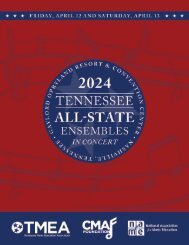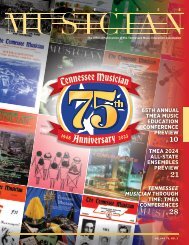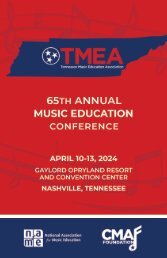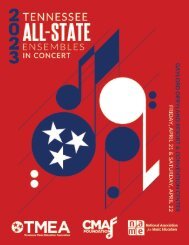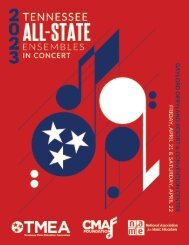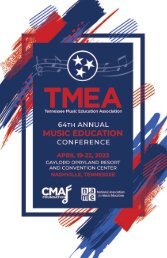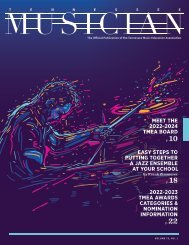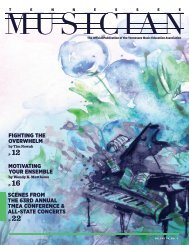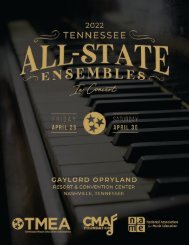Tennessee Musician - Vol. 67 No. 4
Create successful ePaper yourself
Turn your PDF publications into a flip-book with our unique Google optimized e-Paper software.
FLIPERENTIATION<br />
by George Ober<br />
students’ interests, abilities, and learning<br />
preferences.<br />
Differentiated instruction does not<br />
happen by accident. It requires planning,<br />
commitment, and acknowledgment<br />
of the fact that diverse<br />
abilities, experiences,<br />
and interests have a tremendous<br />
impact on student learning.<br />
FLIPERENTIATION:<br />
The concept of “Fliperentiation”<br />
was coined by Joe<br />
Hirsch, an educator at the<br />
Akiba Academy in Dallas, Texas.<br />
He explains that the most<br />
stubborn part of differentiation<br />
is trying to synchronize<br />
the learning of an entire class<br />
so each student learns at their<br />
own pace. “Fliperentiation”<br />
is a pedagogical approach to<br />
teaching in which direct instruction<br />
moves from the<br />
group learning space to the individual<br />
learning space. “Fliperentiation”<br />
combines the<br />
concept of the Flipped Classroom<br />
with a blended, differentiated<br />
learning environment.<br />
FLIPPED CLASSROOM + DIFFERENTIATION = FLIPERENTIATION<br />
eaching in the 21st Century<br />
requires a multi-dimensional<br />
approach to instruction. Fliperentiation<br />
is an In-Class<br />
Flipped instructional approach<br />
to teaching that blends technology<br />
and differentiation in<br />
a flipped classroom context. In such a<br />
flipped and blended environment, technology<br />
is infused in the classroom to accelerate<br />
learning. Students utilize existing<br />
technology to develop their own learning<br />
at their own pace. Teachers employ varied<br />
resources for using instructional technology<br />
to meet individual student learning<br />
styles in a fliperentiated classroom.<br />
FLIPPED LEARNING:<br />
Flipped Learning is a pedagogical approach<br />
in which direct instruction moves<br />
from the group learning space to the in-<br />
dividual learning space. The result is a<br />
group space transformed into a dynamic,<br />
interactive learning environment where<br />
the educator guides students as they engage<br />
creatively in the subject matter.<br />
DIFFERENTIATION:<br />
Differentiated instruction is a teaching<br />
method that allows teachers to structure<br />
learning environments that address<br />
a variety of learning styles, interests, and<br />
abilities found within a classroom. Differentiated<br />
instruction is based on the belief<br />
that students learn best when they make<br />
connections between the curriculum and<br />
their diverse interests and experiences.<br />
Rather than simply “teaching to the middle”<br />
by providing a single avenue of learning<br />
for all students in a class, teachers using<br />
differentiated instruction match tasks,<br />
activities, and assessments with their<br />
The “Fliperentiated Classroom”<br />
operates with two<br />
(2) main objectives as its<br />
focus:<br />
1. Blend learning with<br />
technology to provide differentiation<br />
of instruction in order to meet<br />
the individualized learning needs of<br />
each student.<br />
2. Provide opportunities to further<br />
engage students by allowing them<br />
to work collaboratively on assignments<br />
and projects.<br />
A basic synopsis of the the Flipped<br />
Classroom Model has students learning<br />
and studying content online with meaningful<br />
interactive learning activities, using<br />
video or screen-casts. They then apply<br />
that knowledge in the classroom through<br />
problem-solving and project based assignments.<br />
In a Flipped Classroom, visuals are<br />
all done outside the classroom.<br />
In the Fliperentiation model, students<br />
have a “flipped interactive video component”<br />
and/or a specific app embedded in<br />
the lesson structure to create more opportunities<br />
for differentiated instruction<br />
to increase student engagement while<br />
6 | TENNESSEE MUSICIAN | 2015 | VOLUME <strong>67</strong>, NO. 4



